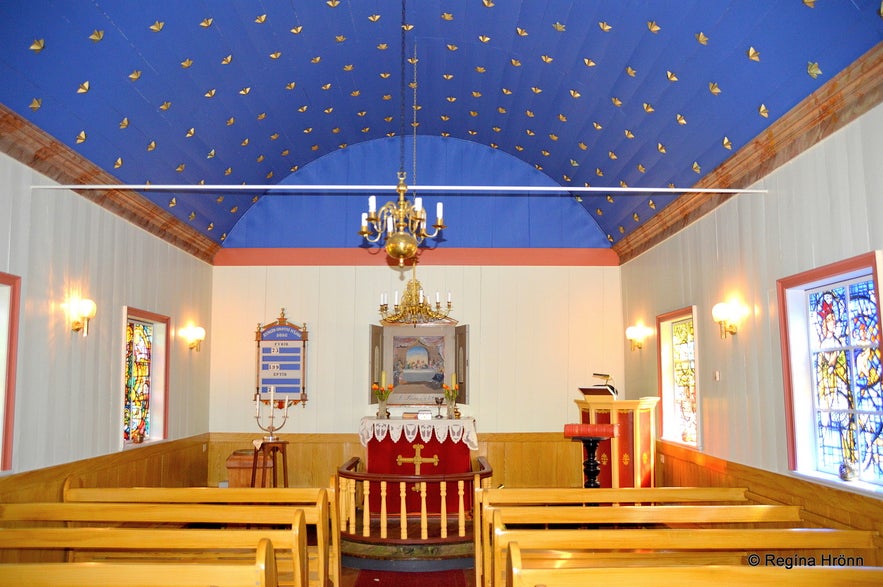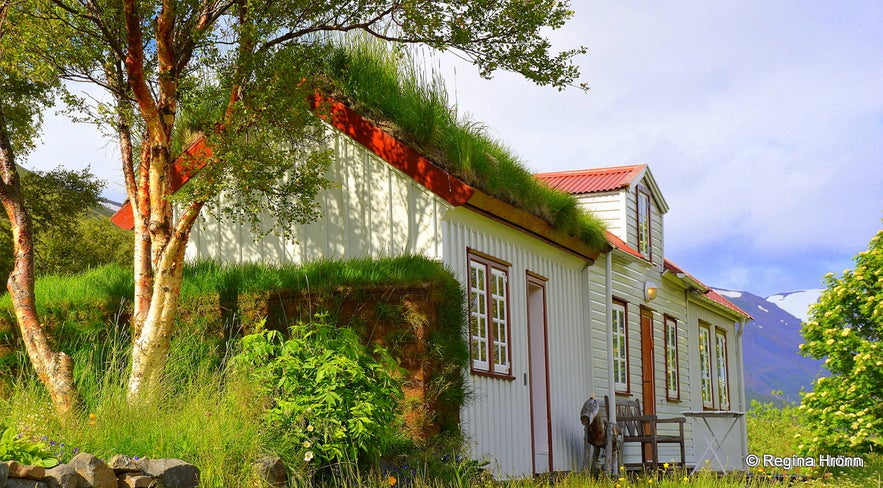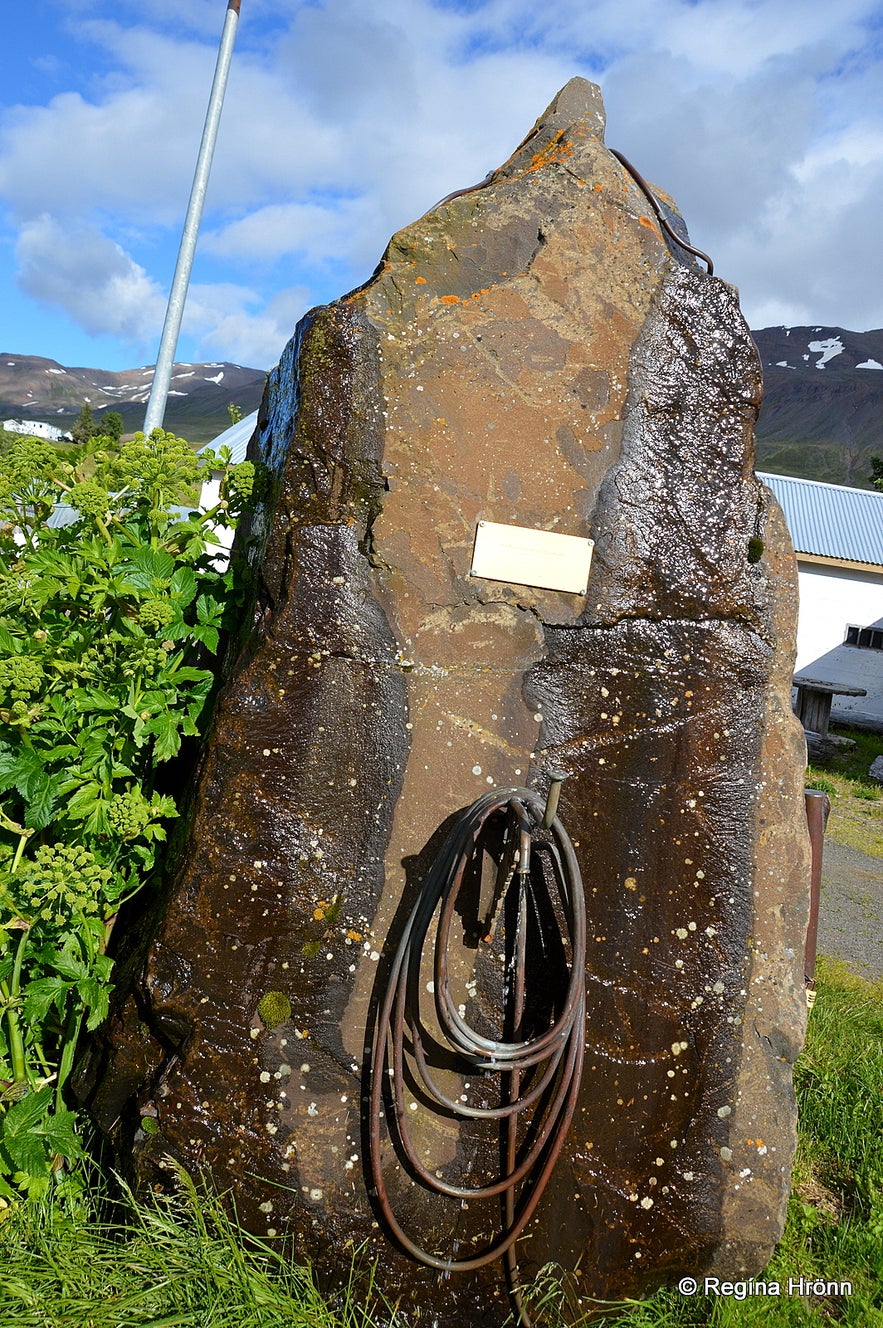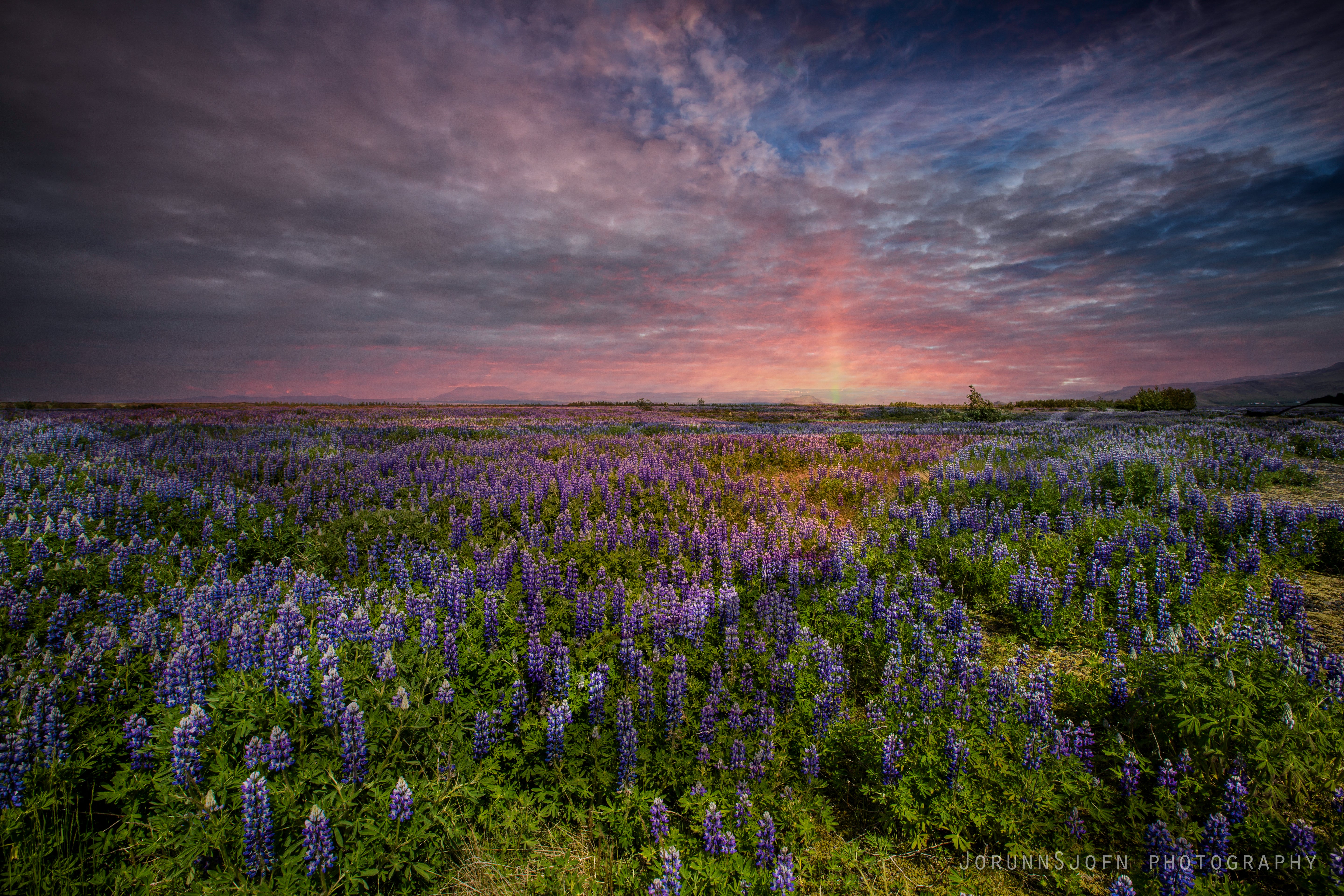
In the historical Svarfaðardalur valley in North Iceland, you will find 3 small and beautiful churches. And a narthex of an old church, which now serves as a chapel. In this travel-blog I am going to tell you a little about these churches.
There is something so special about these churches in Svarfaðardalur valley, they are small timber churches built in the Svarfdælska structural type, which you cannot find anywhere else in Iceland.
Top photo: Tjarnarkirkja church
 Vallakirkja church
Vallakirkja church
You can see a similar church in Öxnadalur valley (Bakkakirkja, which I also visited), Glæsibæjarkirkja church, and the church at Bægisá (remember the Deacon of Dark River and Guðrún), but the churches in Svarfaðardalur are unique.
And to think that in one side-valley from the long Eyjafjörður fjord, there are 4 churches. In Dalvík village you will find a big modern church, Dalvíkurkirkja church, from where these little churches are now served by one minister.
 Dalvíkurkirkja church
Dalvíkurkirkja church
Prior to the Reformation in Iceland in 1550 there used to be small home churches and chapels and small home graveyards by many farms all around Iceland.
After the Reformation, the authorities frowned upon these home churches and wanted them gone.
Earlier on the churches were turf churches and all the houses were turf houses, so the valley looked quite different back then.
You can see the remaining turf houses and turf churches in Iceland in my travel-blog:
A List of the beautiful Icelandic Turf Houses, I have visited on my Travels in Iceland

The little churches soon fell into oblivion, but the 4 parish churches here in Svarfaðardalur valley still remain, which makes this valley very special, as they are a reminder of Iceland in the olden times.
There were 3 ministers as Urðarkirkja church is an annex church from Tjarnarkirkja.
These timber churches have been rebuilt though as they have seen both fires and storms and in the summer of 1900, a gale suddenly hit the valley.
 Urðakirkja church
Urðakirkja church
Urðarkirkja and Upsakirkja churches blew away and broke into pieces, but Tjarnarkirkja which had been built only 8 years prior to the gale, miraculously survived.
Then again in 1934, when a big earthquake 6.2 on the Richter scale (Dalvíkurskjálftinn earthquake) shook this part of Iceland, the timber churches withstood the tremor while many of the houses collapsed.
Tjarnarkirkja church
 Tjarnarkirkja church and the graveyard
Tjarnarkirkja church and the graveyard
First, I am going to show you my favourite church in Svarfaðardalur valley, Tjarnarkirkja church, which was consecrated in 1892.
It didn't get damaged in the church gale in 1900 but started leaning to the north. The story goes that another storm from the north direction balanced the church on its foundation :)
You can see the Svarfdælska structural type in my photo above - the churches in Svarfaðardalur are towerless with a ridged roof, and the two-storey narthex has a less steeply-pitched roof than the church itself (Ref. Kirkjur Íslands - volume 9).
Tjarnarkirkja is the smallest church with this structural type.
 Inside Tjarnarkirkja church - see all the stars on the blue ceiling
Inside Tjarnarkirkja church - see all the stars on the blue ceiling
The "new" Tjarnarkirkja church replaced an older dilapidated turf church at Tjörn, but the turf structures needed constant maintenance. And they were considered to be old-fashioned back then so timber churches were built.
Tjörn is mentioned twice in the old Icelandic Valla-Ljóts saga, but the first record of a church here at Tjörn is from 1318.
It was dedicated to the Virgin Mary, the Archangel Michael, St. John the Baptist, and St. Andrew the Apostle.
 Stained glass windows in Tjarnarkirkja - Virgin Mary
Stained glass windows in Tjarnarkirkja - Virgin Mary
There are beautiful stained glass windows in Tjarnarkirkja church by Valgerður Hafstað in 1961 and 1968.
They depict ancient motifs found at Þjóðminjasafn Íslands - The National Museum of Iceland and elsewhere (don't know where).
The pulpit and the altar were made for the timber church at Tjarnir.
The Danish altarpiece in Tjarnarkirkja dates back to 1818 and comes from the old turf church. It was a present from Árni Snorrason who served at Tjörn from 1815-1833.
 The altarpiece is of the Last Supper
The altarpiece is of the Last Supper
If you look at the name on the altarpiece then it is the name of Árni, but it was not unusual back then for the doner to have his name written on the altarpiece and not the name of the painter.
I want to tell you one story which is told in Kristján Eldjárn's book "Arngrímur málari", but Kristján, who was later to become the 3rd President of Iceland (1968-1980), was born here at Tjörn and his grandfather had been a minister at Tjörn.
Among the ministers who served here at Tjörn was Hjörleifur Guttormsson, but he served at Tjörn until 1878.
 Inside Tjarnarkirkja church
Inside Tjarnarkirkja church
Hjörleifur was the father-in-law of the folk artist Arngrímur, but you might remember him from my travel-blog about Skinnastaðakirkja church in Axarfjörður.
Arngrímur is buried at the graveyard at Tjörn, you will notice a rusty iron cross facing the church door, and you can visit his atelier Arngrímsstofa close by.
Guðlaug Björnsdóttir, the wife of the minister Hjörleifur, died at Tjörn and was buried in the graveyard here. But later on, Hjörleifur moved from Tjörn church and served at Vallakirkja church across the Svarfaðardalsá river.
 Tjarnarkirkjugarður - the graveyard at Tjörn
Tjarnarkirkjugarður - the graveyard at Tjörn
Hjörleifur wanted to be buried in that graveyard so he moved his deceased wife to that graveyard.
But as fate has it then Hjörleifur died when he was visiting his daughters in Kelduhverfi in northeast Iceland and was buried at Garður in Kelduhverfi and not beside his wife at Vellir.
His descendants, much later on in 2017, wanted him to be reburied next to his wife, so they moved the body and now Hjörleifur lies next to his beloved wife Guðlaug.
 Tjarnarkirkja church
Tjarnarkirkja church
A touching story. One of Hjörleifur's great-great-granddaughters is a close relative of mine and she was one of the descendants to move him from Kelduhverfi to Svarfaðardalur valley.
Tjarnarkirkja church was renovated in 1992 and is very well maintained.
Now, let's follow the Svarfaðardalur valley on the same side of the river and visit Urðakirkja church.
Urðakirkja church
 Urðakirkja church
Urðakirkja church
The Svarfaðardalur valley turns a bit and splits into two, Skíðadalur valley, where Skíði from the Svarfdæla saga used to live.
But we are going to follow the same valley until we reach the farm Urðir. Urðir means a rocky slope and the farm and the church are built on a slope.
Urðir farm is only mentioned once in the Svarfdæla saga, so we don't know much about the old history of this farm. The first mention of the church is in the cartulary of Bishop Auðunn at Hólar from 1318.
 Inside Urðakirkja church
Inside Urðakirkja church
Urðakirkja church was the only church that was a farmer's church, i.e. built by and in the possession of the farmer.
The farmer at Urðir farm showed us the well-maintained Urðakirkja church and told us about the latest improvements. My husband and I are always disturbing the working farmers in Iceland asking them for the keys to the church on their land.
But the farmers at Urðir were ever so nice and opened the church for us and told us in detail about the new renovations of the church, which we very much appreciated.

The old pulpit in Urðakirkja church dates back to 1766 and was painted by Jón Hallgrímsson
Urðakirkja was built in 1902 after the previous timber church from 1850 blew away in the big storm in the year 1900. This storm has been called "kirkjurokið" or the church gale.
The church that blew away and was totally destroyed was the first timber church to be built in Svarfaðardalur valley. Many old artifacts were damaged in the church gale.
But there are some old artifacts left in the church and the old pulpit in Urðakirkja church dates back to 1766.
 The altarpiece in Urðakirkja church dates back to 1880
The altarpiece in Urðakirkja church dates back to 1880
The old altarpiece is painted by the noted Arngrímur Gíslason painter in 1880 and depicts the Last Supper, it was damaged in the storm, but repaired.
Arngrímur painted 10 altarpieces that we know of, 2 of which are lost.
I showed you Arngrímur's turf house atelier in Svarfaðardalur valley in my last travel-blog.
 Arngrímsstofa belongs to the National Museum of Iceland
Arngrímsstofa belongs to the National Museum of Iceland
There are also some old church bells in Urðakirkja church, which date back to 1756 and around 1534.
Urðakirkja church is one of the buildings which look bigger on the inside than on the outside and the interiors are ever so beautiful, so it is well worth a visit.
 Inside Urðakirkja church, it was very bright outside
Inside Urðakirkja church, it was very bright outside
Now, let's drive back, cross the river Svarfaðardalsá and visit Vallakirkja church.
Vallakirkja church
 Vallakirkja church
Vallakirkja church
Vallakirkja church, on the other side of the Svarfaðardalsá river, was the oldest one of the remaining timber churches in Svarfaðardalur valley, built in 1861. It replaced an older turf church.
In the olden times, Vallakirkja was dedicated to King Olav helgi (the holy) Haraldsson of Norway.
At Vellir lived Valla-Ljótur Ljótólfsson (born around 920) from the Valla-Ljóts saga. He was the son of the Chieftain Ljótólfur at Hof in Svarðardalur, one of the protagonists in the Svarfdæla saga.
 Inside Vallakirkja church
Inside Vallakirkja church
In 1996 the church underwent refurbishment when tragedy struck. The church caught fire and was greatly damaged together with many of the invaluable church objects.
Now, these churches are dear to us and when a church burns to the ground, everybody chips in for a new church.
A new Vallakirkja church was built from 1997-2000 in the liking of the old one and consecrated in 2000.
 Inside Vallakirkja church
Inside Vallakirkja church
The same tragedy struck Miðgarðakirkja church in Grímsey in 2021, it burn to the ground.
Everybody chipped in and we are hoping for the new church to be consecrated in the near future if all goes well.
You can see my travel-blog about Grímsey, the gem of the Arctic Circle for photos of that church. Arngrímur Gíslason also painted the altarpiece in Miðgarðakirkja church, but everything was lost in the fire.
 The altarpiece in Vallakirkja church
The altarpiece in Vallakirkja church
Fortunately, the altar was saved from the Vallakirkja church but the altarpiece was damaged and a new one was painted by Guðríður Valva Gísladóttir.
It was painted to the liking of the old altarpiece, not an exact replica though, as it was said that the old altarpiece had not been a great work of art.
You might notice that in all these churches in Svarfaðardalur valley the altarpiece depicts the Last Supper.
 The pulpit in Vallakirkja church
The pulpit in Vallakirkja church
A replica was also made of the old pulpit from 1747. The apostles are painted on the pulpit in a liking to the old pulpit.
You will see a beautifully carved baptismal font in Vallakirkja church, which is an exact replica of the old font from 1946 which burnt down with the church in 1996. It was made in 2000.
I have never been as close to the stars as inside Vallakirkja church.
 I could touch the stars on the ceiling in Vallakirkja church
I could touch the stars on the ceiling in Vallakirkja church
Guðmundur góði - the good Arason was a priest at Vellir from 1190-1197 prior to becoming the Bishop at Hólar from 1201-1237.
He served at Upsir for some years before he moved to Hólar due to a dispute he had while serving at Vellir.
I have told you about Guðmundur góði in several other travel-blogs as many springs in Iceland were blessed by Guðmundur and are believed to have healing properties.
These springs are called Gvendarlaug, like the ones I have shown you in this travel-blog: Hotel Laugarhóll at Strandir - hot Pools and Sorcery in Abundance
 Guðmundar steinn hins góða - the Rock of Guðmundur the Good
Guðmundar steinn hins góða - the Rock of Guðmundur the Good
I have also told you about Guðmundur in my travel-blog about Hólar in Hjaltadalur.
The water is believed to have some healing properties. You can get some holy water from the "fountain" on the right side of the church.
Svarfaðardalur valley is located southwest of the northern part of the long Eyjafjörður fjord. We will now drive through the village Dalvík, pass Dalvíkurkirkja church, and visit the Upsakapella chapel.
Upsakapella chapel
 Upsakapella
Upsakapella
The church at Upsir has also been through a great ordeal through the years and now only the narthex is left.
A new church had been erected in 1853-54 at Upsir. Only a couple of years later, in 1857, Upsakirkja church blew off its foundations in a tempest and landed on its roof. It was repaired but tragedy struck again.
The church at Upsir blew away in the great church gale in the year 1900, which I have told you about earlier in this long travel-blog of mine, which caused a lot of damage in this area.
 Upsakapella - the Chapel at Upsir
Upsakapella - the Chapel at Upsir
A new church was built at Upsir. That church was demolished when the new Dalvíkurkirkja church was erected in 1960 and only the narthex of that old church is used as a chapel.
Upsir is a historic place and here Karl hinn rauði - Karl the Red, the son of Þorsteinn svörfuður, lived. He had lived at Grund but moved to Upsir at the request of his dying father.
Þorsteinn svörfuður is the one from which Svarfaðardalur valley got its name.
 Upsakapella and Dalvíkurkirkja church in the distance
Upsakapella and Dalvíkurkirkja church in the distance
And here the Bishop Guðmundur góði - Guðmundur the good, served for a couple of years at the end of the 12th century before he became a bishop at Hólar. He was the first minister mentioned at Upsir.
One of the old artifacts at Þjóðminjasafn Íslands - the National Museum of Iceland is a Holy Rood called Ufsakrossinn or Ufsakristur.
It is from an old church at Upsir (Ufsir) and most likely dates back to the 12th century. It was donated to the museum after the old church was torn down, together with an old altarpiece - a triptych from the church.
 Ufsakristur at Þjóðminjasafn Íslands - the National Museum of Iceland
Ufsakristur at Þjóðminjasafn Íslands - the National Museum of Iceland
The Christ from Ufsir is one of the key artifacts at the museum and is the oldest crucifix we own of this type, so it is quite valuable.
Ufsakristur is a 180 cm tall figure of Christ with outstretched arms (80 cm) made from a birch log. Only the statue is left but the crucifix itself is lost.
Ufsakristur is in pure Romanesque style, with a crown of a king on his head and not a crown of thorns, depicting him as a winner.
 The information sign at Upsir
The information sign at Upsir
I hope that my travel-blog about the churches in Svarfaðardalur valley has sparked your interest in visiting the valleys of Iceland, which are often overlooked by travellers.
I have written 2 other travel-blogs about this lovely valley, which is close to my heart.
Have a lovely time in Svarfaðardalur valley :)
Ref.
Kirkjur Íslands - Volume 9
Norðurslóð 1982 - Gömlu kirkjurnar í Svarfaðardal - Kristján Eldjárn













